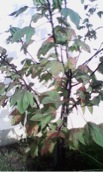Roselle
| Roselle | |
| Scientific Name | Hibiscus sabdariffa L |
| Synonyms | Hibiscus digitatus Cay |
| Family | Malvaceae |
 |
{slider=Common Name}
Asam paya, asam susur, asam kumbang
{/slider}
{slider=Description}
Annual, erect stem, grow up to 4 m tall. Leave simple, alternately arranged, polymorphic, measuring 8-15 cm x 6-14cm. Annual /perennial grown to 3 m. The flowers are hermaphrodite (have both male and female organs) and pollinated by insects. It prefers moist soil.
{/slider}
{slider=Geographical Distribution}
Probabaly from Africa
{slider=Traditional Uses}
Traditional rose tea and is used effectively in folk medicines against hypertension, inflammation and mutagenicity.
{/slider}
{slider=Chemical Constituents}
The dried calyces contain the flavonoid gossypetin, hibiscetine and sabdaretine. Pigment: hibiscin, daphniphylline, myrtillin, chrysanthenin and delphinidin
{/slider}
{slider=Pharmacology}
Uricosuric activity: H. sabdariffa significantly decreased serum oxalate and glycolate and caused exretion of oxalates in rats (Prasongwatana V. et al 2008).
Antimicrobial: H. sabdariffa was effective in inhibiting E. coli O157:H7 (Fullerton M., 2011).
Atherosclerosis: H. sabdariffa inhibits serum lipids and shows an antiatherosclerotic activity (Chen C. 2003)
Liver disease: Hibiscus pigments reduced the incidence of liver lesions including inflammatory, leucocyte infiltration, necrosis induced by t-BHP in rats (Wang C.J. 2000).
Cancer: Dried flower extracts of H. sabdarrifa L. Protect rat hepatocytes from t-BHP-induced cytotoxicity and genotoxicity (Tseng T H. 1997)
{/slider}
{slider=Toxicity Test}
Very high doses of extracts of H. sabdariffa could be toxic to the hepatic system, and cause muscular dystrophy. The water extract, usually taken as a beverage, exhibited an ability to cause an increase in serum creatinine, while the extracts obtained with alcohol (absolute and 50 %) had more damaging effects on the liver function enzymes in addition to an increase in plasma creatinine levels (Fakeye T.O., et al 2008)
{/slider}
{slider=Reference}
Prasongwatana V, Woottisin S., Sriboonlue P., Kukongviriyapan V. (2008). Uricosuric effect of Roselle (Habiscus sabdariffa) in normal and renal stone former subjects. J. Ethnopharmacol, 117 (3): 491-5.
Fullerton M, J. Khatiwada, J. U. Johnson, S. Davis and L.L. Williams (2011). Determination of Antimicrobial Activity of Sorrel (Hibiscus sabdariffa) on Escherichia coli 0157:H7 Isolated from Food, Veterinary and Clinical Samples J. Med Food ,14(9); 950-956.
Chen C.C., Hsu JD. Wang SF , Chiang HC., Yang MY, Kao ES, Ho YC and Wang C.J (2003). Hibiscus sabdariffa Extract Inhibits the Development of Atherosclerosis in Cholesterol Fed Rabbits. J. Agric Food Chem ; 51 (18) ; 5472-5477.
Tseng TH, E.S. Kao, C. Y. Chu, F.P. Chou, H.W. Lin Wu, C.J. Wang (1997). Protective effects of dried flower extracts of Hibiscus sabdariffa L. Against oxidative stress in rat primary hepatocytes. Food and Chemical Toxicology; 35 (12); 1159-1164.
Wang C.J., J.M. Wang, W.L. Lin, C.Y. Chu, F.P. Chou, T. H. Tseng (2000). Protective effect of Hisbiscus anthocyanins against tert-butyl hydroperoxide-induced hepatic toxicity in rats. Food and Chemical Toxicology. 38 (5) Pg 411-416.
Fakeye T.O., A. Pal, D.U. Bawankule, N.P. Yadav and S.P.S. Khanuja (2008). Toxic effects of Oral Administration of Extracts of Dried Calyx of Hibiscus sabdariffa Linn. (Malvaceae). Phytotheraphy Research DOI: 10.1002/ptr. www.interscience.wiley.com.
{/slider}
- Last updated on .
- Hits: 1054
